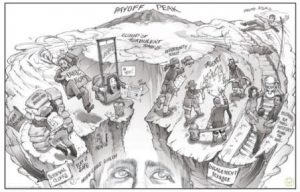MetLife, a leading global insurer, is using an agile marketing approach to unlock the power of self-governing teams, drive business growth, and connect with consumers.

“Pet insurance is a business that has a huge amount of white space,” said Sabrina Sebastian. “There was a significant opportunity to expand awareness and penetration rate of pet insurance which is less than 3% for all pet parents today.”
In 2019, global insurance provider MetLife had acquired PetFirst, a pet health insurance company founded in 2004. After the acquisition, Sebastian, PetFirst’s former CFO, and now MetLife’s AVP for Pet Insurance Marketing, was tasked with growing the MetLife Pet Insurance division.
In 2021, there were approximately 135.2 million dogs and cats owned by Americans, with about 3.9 million U.S. pets (mostly dogs and cats) insured that year. As a growth-focused business, MetLife saw a significant opportunity to expand the pet insurance division. They’d been using a traditional marketing workflow with modular teams that were highly skilled in marketing.
Said Sebastian, “If we needed to tap into other teams, we would do that, but it was a really traditional way of working. We discovered that we also needed to rely heavily on our tech partners, our data partners, and our business partners.”
This need is what drove the shift from a traditional marketing approach to an agile marketing framework.
Bringing cross-functional teams together
Agile marketing, which has its roots in software development, is a way for marketers to respond rapidly to the changing needs of customers and drive successful business outcomes. It’s done through a team-based approach using collaborative practices. This new way of working empowers marketers to do the right thing for the customer at the right time, eliminating a lot of wasteful process overhead.
“It’s a very natural way of working when you need to tap into another skill set or another opportunity that exists outside your core team,” said Sebastian. “When we started to think about how we wanted to operate and work differently, we asked ourselves, okay, what do we need to be able to do that?”
MetLife was already using agile pods in certain departments within the organization. Their global CFO and other senior leaders within the company provided the support that Sebastian needed to move from a traditional marketing to an agile marketing approach.
“We had the support and the executive sponsorship of the MetLife global CMO. He was behind these efforts and got everybody else excited about that,” said Sebastian. “It was great to have that support starting at the top and from senior leaders in all areas of the business. It really does require a cross-functional team.”
In addition to buy-in and support from leadership, Sebastian was focused on how to put together her multidisciplinary marketing team. She ultimately approached all the teams that needed to be involved in the process including traditional marketing, content strategy, data and analytics, technology, and the more traditional IT and infrastructure teams.
“We went to those leaders and said, okay, we’re putting together this team and we’re putting together a new way of working and we want to tap into the resources that you have,” said Sebastian.
When bringing together cross-functional teams, Sebastian emphasized the importance of starting foundationally and understanding that not everybody is a marketer. Marketing needed to take a step back and educate various teams on what they were doing, why they were doing it, and how they were planning to get it done.
“Ultimately, we needed to get them ingrained in the actual business goals that we had in front of us, said Sebastian. “A lot of these people had never worked on Pet before. Then secondarily, a lot of the people had never been part of a marketing team before. So, we had to do a lot of training and education and really just make sure folks were on the same page.”
Getting agile off the ground
To get the agile group up to speed with the pet insurance division’s new agile marketing approach, Sebastian’s team did some on-site training to make sure that everybody understood the foundations and principles of agile marketing. This also allowed the team to get to know each other.
“Part of the agile marketing process is just making sure that the team stays connected,” said Sebastian. “There are daily stand-up meetings and different ceremonies that take place throughout the process to make sure that everyone is on the same page. We also did a fair bit of education and work on our side to make sure that everybody was comfortable and getting to know each other as a team.”
The agile marketing approach is collaborative. That extends to the way teams are lead and managed. Instead of a single manager or leader, there are Product Owners (POs) that help facilitate communication and keep people connected. One of the principles of agile marketing is the team is self-functioning and self-governing.
“It’s not that there’s not someone in charge,” said Sebastian, “But there’s not someone who’s the boss. You depend on the team to manage itself. We have a PO that does an amazing job of organizing all of the things that need and managing the activities that a PO should.”
Focusing on outcomes and business impact
One of the biggest challenges that Sebastian’s team had to overcome, beyond the de-siloing of teams, was to adopt a more business-focused mindset when it came to goals. That is, when teams are isolated from each other, they tend to focus on the goals of that specific team, whether it’s marketing, sales, technology, or business.
“The great thing about Agile is that the business goal is really the guiding principle of what we’re all working towards every single day,” Sebastian explained. “So we’re making sure that we stay close to that goal and understand the ‘why’ behind the work that we’re doing.”
Said Stacey Ackerman, partner at NavigateAgile and MarTech contributor, “It’s really common in marketing to be going 100 miles an hour trying to do as much as possible, but if you ask anyone what goal they’re trying to achieve for the business or the customers, most marketers have no idea. What I love about agile marketing is that everyone from senior leaders to the team executing the work is aligned and working towards the same outcome. Therefore, marketers that are really succeeding with agile marketing are actually doing less work with better results,”
MetLife’s agile approach is focused on outcomes and adding value versus just being busy. It’s a big-picture mindset that ties marketing activities to those outcomes that add value to the business. “That’s one of the ways that we really have seen a shift in our team,” said Sebastian. “We’re not just doing things. We’re doing things that are really impactful, are adding value, and are helping us get closer to those big business goals that we have.”
Sebastian notes two key achievements from having implemented an agile marketing methodology within MetLife. The first is that, while there were already several other agile pods within the company, her agile team has been able to blaze the trail for agile marketing. “We’re laying out the foundation for how an agile pod should work. And we’re able to share that knowledge across the organization.”
Sebastian confirmed that they’re selling more policies now than they ever have. Year over year growth is in double digits. “This is definitely a way of working that we’d like to continue to expand at MetLife, specifically in the marketing space,” said Sebastian. “We’ve seen really significant impacts from the work that we’ve been doing.”
“The other thing that’s interesting is that we have a direct connection with the consumer. MetLife is a voluntary benefits company, so we have a large portion of our efforts concentrated in the group business, but we also have the opportunity with Pet to go direct to consumer. That’s one of the reasons that Pet was a good fit for agile marketing. We’re all about meeting pet parents where they are. Being able to connect in meaningful ways to the consumer, regardless of where you find them, has been really impactful for us.”
The post MetLife uses agile marketing to unleash pet insurance sales appeared first on MarTech.
MarTech(8)







